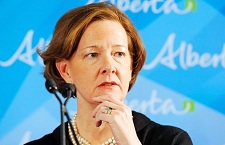

As the federal Canadian political scene solidified with the New Democratic Party’s selection of a leader last Saturday, attention this week has turned west to Alberta, where Premier Alison Redford (above, top) has called a long-awaited general election for April 23.![]()
![]()
Alberta, Canada’s fourth-largest by population and its richest by GDP per capital, is an odd province politically — it has been governed by a conservative party for over a century, going back to 1917, when the United Farmers of Alberta entered electoral politics and swept the Liberal Party out of office. In 1935, the more radical Social Credit took power — and stayed there until 1971, largely under the premiership of Ernest Manning, who served from 1943 to 1968, governing Alberta with a strongly Christian and prairie populist political power base that had little do with the “social credit” theories from which the party’s name originated. Thereafter, the Progressive Conservatives took power, where they’ve remained ever since; under the premiership of Ralph Klein from 1992 to 2006, Alberta generally prospered with a strong economy buoyed by oil wealth as well.
Klein’s successor, Ed Stelmach, continued the streak in the 2008 elections, in which the Progressive Conservatives won 72 of the 83 seats in Alberta’s legislative assembly (the Liberals took 9 and the NDP the other 2).
But times being rough with a financial crisis, and with 41 consecutive years in power tricky for any party to navigate (let alone in a society with open elections), Stelmach’s popularity waned and Redford succeeded him last October.
With the Liberals and NDP terminally unpopular in Canada’s most reliably conservative — culturally and economically — province, it seems unbelievable that it took so long for a new conservative alternative to emerge.
That alternative — the Wildrose Party, so named for the wild roses that grow in the prairie province, burst onto the scene in 2008 and started to lead polls for the first time in 2010 (at the same time a little certain conservative movement in the United States was making trouble on the far right as well). Its popularity waned as the economy seemed to improve and as Redford emerged, but it has now gradually clawed back into an essential tie for first place under leader Danielle Smith (above, bottom).
The latest polls, as analyzed by ThreeHundredEight, show that if the election were held today, Wildrose would win anywhere from 32% to 40% of the vote to a range of 39% to 31% of the vote for the PC. The Liberals and the NDP both trend a little above 10% in the 11% to 13% range.
So it’s on! In the span of under four weeks, the four-decade dominance of the PC could come crashing to an end in Alberta.
But what is Wildrose? How did it emerge, what makes it tick, how is it different from the PC and how would it govern?
The party is a bona fide grassroots Alberta-grown movement reminiscent of the Social Credit of bygone decades (and of the PC when it took power from Social Credit in 1971, perhaps), but infused with the social conservatism and spending-averse hallmarks of the U.S. tea party movement as well — it appeals to older and more conservative voters, just as the U.S. tea party movement.
Smith, untested but popular, is a former journalist who once worked in an oil patch. She’s never served as a member of the legislative assembly (as an “MLA”), and her chief political experience seems to have been serving on the board of trustees for the Calgary Board of Education. It’s not mayor of Wasilla, but she’s become a phenom in Albertan politics not so completely unlike Sarah Palin.
On the campaign trail, Smith tut-tuts the free-spending ways of the PC government and vows to rein in spending and save more of the province’s wealth. She has also highlighted of the sleaze factor of a party that’s been in office too long — attacking, for example, pensions that Alberta MLAs receive.
Polls generally credit Redford with more respect from voters and Smith with more likeability. The PC still leads in Edmonton (the capital), but Calgary (Alberta’s largest city) is currently a toss-up and the rest of the province is tight, with a narrow lead for Wildrose.
But Wildrose is also untested — so while the PC is known quantity, one wrong move could sink Wildrose, as the Calgary Herald‘s Don Braid notes:
There are few Tory sins Albertans don’t know all about, after observing them for much of a lifetime. But Wildrose, with its image still forming in the public mind, could sink itself with one sideways move.
3 thoughts on “Alberta’s Tea Party makes a run at power”